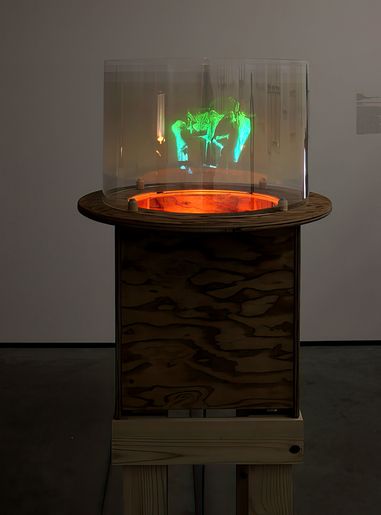Huddle

Simone Forti
Huddle, 1976
Integral-Hologram (Multiplex) Perspex reinforced, polymer blend, electric light, wood Hologram: 30.4 cm (height), diameter 44.5 cm Circular platform: 1.8 cm h(height), diameter 54.5 cm, Base upper part: 39 x 37.5 x 36.5 cm Base bottom part: 91.4 x 38.7 x 38 cm Total: 162.4 x 54.5 x 54.5 cm Produced by Lloyd Cross
GF0031732.00.0-2015
Artwork text
First staged in 1961, the performance Huddle is a key work by the visual artist, dancer, and choreographer Simone Forti. A leading figure in postmodern dance, she has enriched the classic dance techniques with their focus on perfect body control by adding natural workaday and improvised movement sequences. Huddle straddles the boundary between sculpture and dance: the participants form a circle, bending forward, their arms around each other’s waists and shoulders. One individual climbs atop the others, using their shoulders as a ladder, then slides down into the center of the circle and rejoins the group. The piece is an experiment exploring the transcendence of physical boundaries in a community. The video documents a performance of the piece in the artist’s studio. In the hologram, Forti translates an isolated movement sequence into a three-dimensional immaterial image. Her objective is to focus the attention on a single act, not unlike in a haiku, a traditional Japanese poetic form that consists of only a few syllables and lines. The holographic image differs considerably from the video image. It appears to hover above the base and is oddly elusive, its shape and colors shifting with even the smallest movement. The ensemble’s powerful physical presence, which is still palpable in the video, is transmuted by the hologram into a ghostly light phenomenon. Invented in 1947, holography is a technology that underscores the gulf between real bodily presence and its media representation. So-called multiplex holograms are elaborate productions. A device comprising a projector, lasers, and lenses transfers a filmed motion sequence to a holographic film, which is then laminated onto plexiglass. The hologram is illuminated by a light source, making thousands of vertical slits in the curved plexiglass disk visible that resemble the scan lines of early television. Our memory assembles them in a stereoscopic image, and it is we, the viewers, who animate that image by moving around the object. (JT)